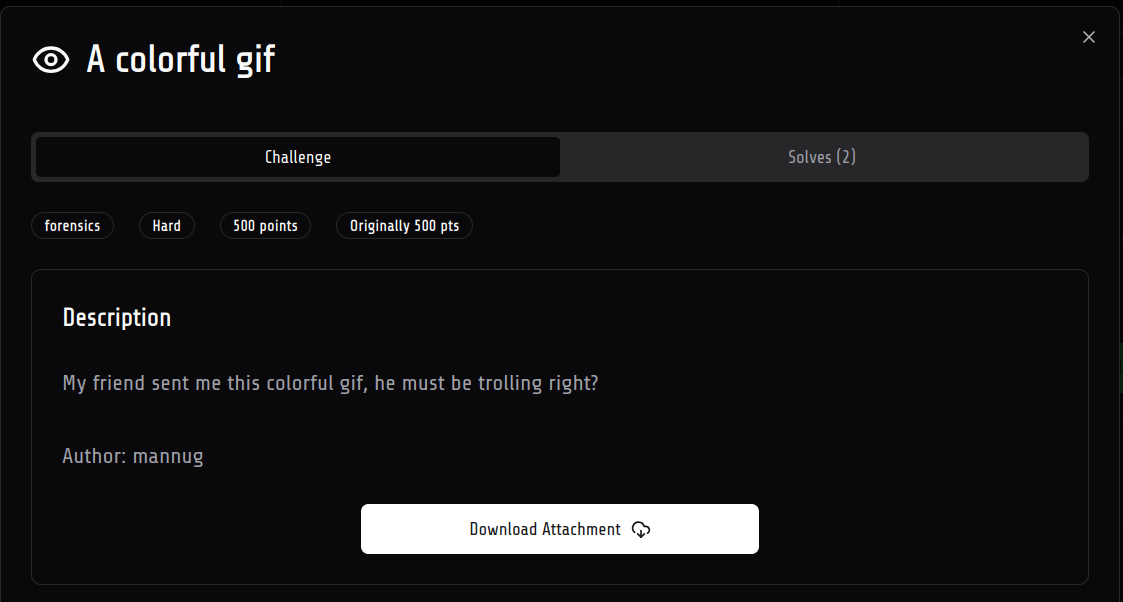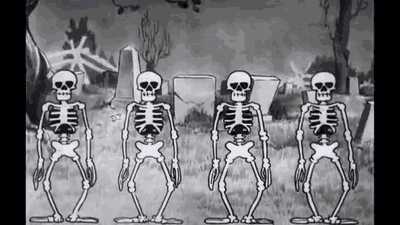07 CTF colorful gif writeup
A colorful gif
 Description -
Description - My friend sent me this colorful gif, he must be trolling right?
Handout
Solution
At first glance, it looks like a normal gif , but i saw the contrast between the name of the challenge and the gif was black and white , so i thought maybe the flag is hidden in the color channels of the gif
i researched about gif format and found different things , first i extracted the frames to see what can be wrong with them . there were 140 total frames , i found nothing wrong in them
The challenge was related to colors so i moved back to the colours and i knew that colors in GIF are stored in a palette in form of a color table , there are global color table and local color table . let us understand this in detail
GIF data (Theory)
1
2
3
4
5
6
7
8
9
10
11
12
13
14
15
16
17
18
19
20
21
22
23
24
25
26
+--------------------------+
| GIF Header |
+--------------------------+
| Logical Screen Descriptor|
+--------------------------+
| Global Color Table |
+--------------------------+
+--------------------------+
| Application Extension |
+--------------------------+ +-----------+
| GIF Data |
+-----------+
+--------------------------+
| Graphic Control Extension|
+--------------------------+
| Image Description |
+--------------------------+
| Image Description |
+--------------------------+
| Image Data |
+--------------------------+(per frame)
+--------------------------+
| Trailer |
+--------------------------+
- this was the main structure of the gif file , there are mainly two version of GIF87a and GIF89a , the difference is that GIF89a supports transparency and animation
- Logical Screen Descriptor - it contains the width and height of the gif , and some flags to indicate if there is a global color table or not
- Global Color Table - it contains the colors used in the gif , each color is represented by 3 bytes (RGB)
- Application Extension - it contains some metadata about the gif like the loop count , block size etc
- Image Descriptor - this is the per frame data , it contains the position of the frame in the logical screen , and some flags to indicate if there is a local color table or not
- Local Color Table - it contains the colors used in the frame , each color is represented by 3 bytes (RGB)
- Graphics Control Extension - It tells each frame how long to stay on screen.
- Image Data - This containts the actual picture data for each frame.
- Trailer - this contains a single byte to indicate the end of the gif file containing hexadecimal 0x3B which is ‘;’ in ascii
Moving forward with the solution
- the next step was to check if there is a global color table or not , and if there is a local color table or not
- i used a script to parse the gif file and extract the global color table and local color table if they exist
1
2
3
4
5
6
7
8
9
10
11
12
13
14
15
16
17
18
19
20
21
22
23
24
25
26
27
28
29
30
31
32
33
34
35
36
37
38
39
40
41
42
43
import struct
def read_global_color_table(file_path):
with open(file_path, 'rb') as f:
# Skip GIF Header (6 bytes: GIF87a or GIF89a)
f.read(6)
# Read Logical Screen Descriptor
screen_width, screen_height = struct.unpack("<HH", f.read(4))
packed_fields = struct.unpack("<B", f.read(1))[0]
bg_color_index = struct.unpack("<B", f.read(1))[0]
pixel_aspect_ratio = struct.unpack("<B", f.read(1))[0]
# Check if Global Color Table exists (bit 7 of packed_fields)
gct_flag = (packed_fields & 0b10000000) >> 7
if gct_flag:
# Determine the size of the Global Color Table
gct_size_bits = packed_fields & 0b00000111
gct_size = 2 ** (gct_size_bits + 1)
print(f"Global Color Table Size: {gct_size} colors")
# Read Global Color Table
gct_data = f.read(3 * gct_size) # Each color is 3 bytes (RGB)
# Create a list of RGB triplets
gct_colors = [(gct_data[i], gct_data[i + 1], gct_data[i + 2]) for i in range(0, len(gct_data), 3)]
# Write Global Color Table to gct.txt
with open('gct.txt', 'w') as out:
for i, color in enumerate(gct_colors):
out.write(f"{i}: {color[0]} {color[1]} {color[2]}\n")
return gct_colors
else:
print("No Global Color Table present.")
return []
def rgb_to_hex(r, g, b):
return "#{:02x}{:02x}{:02x}".format(r, g, b)
colors = read_global_color_table('colorful.gif')
Explanation of GCT script
read_global_color_table(file_path) - this function reads the gif file and extracts the global color table if it exists and writes it to gct.txt
now extracting the local color table
1
2
3
4
5
6
7
8
9
10
11
12
13
14
15
16
17
18
19
20
21
22
23
24
25
26
27
28
29
30
31
32
33
34
35
36
37
38
39
40
41
42
43
44
45
46
47
48
49
50
51
52
53
54
55
56
57
58
59
60
61
62
63
64
65
66
67
68
69
70
71
72
73
74
75
76
77
78
79
80
81
82
def format_palette_bytes(palette_bytes):
if not palette_bytes:
return "N/A"
colors = [tuple(palette_bytes[i:i+3]) for i in range(0, len(palette_bytes), 3)]
return ", ".join(map(str, colors))
def skip_data_sub_blocks(file_handle):
while True:
block_size = file_handle.read(1)
if not block_size or block_size == b'\x00':
break
file_handle.read(int.from_bytes(block_size, 'little'))
def find_all_lcts(file_path, output_path):
with open(file_path, 'rb') as f, open(output_path, 'w') as log:
log.write(f"Local Color Table Analysis for: {file_path}\n")
log.write("=" * 50 + "\n\n")
# --- Header and Logical Screen Descriptor ---
f.read(10) # Skip header and screen dimensions
packed_fields = int.from_bytes(f.read(1), 'little')
gct_flag = (packed_fields & 0x80) >> 7
gct_size_val = packed_fields & 0x07
f.read(2) # Skip background color index and pixel aspect ratio
# --- Skip Global Color Table (GCT) ---
if gct_flag:
gct_length = 3 * (2 ** (gct_size_val + 1))
f.read(gct_length)
# --- Main Loop to Find All Frames ---
frame_counter = 0
while True:
block_type = f.read(1)
if not block_type:
log.write("End of file reached.\n")
break
# Extension Block
if block_type == b'\x21':
f.read(1)
skip_data_sub_blocks(f)
# new frame
elif block_type == b'\x2C':
log.write(f"--- Frame {frame_counter} ---\n")
f.read(8)
packed_field = int.from_bytes(f.read(1), 'little')
lct_flag = (packed_field & 0x80) >> 7
lct_size_val = packed_field & 0x07
if lct_flag:
log.write("Status: Local Color Table (LCT) FOUND\n")
lct_length = 3 * (2 ** (lct_size_val + 1))
lct_data = f.read(lct_length)
log.write(f"Size: {lct_length} bytes ({lct_length // 3} colors)\n")
log.write(f"Values: {format_palette_bytes(lct_data)}\n\n")
else:
log.write("Status: No LCT found (uses GCT)\n\n")
#Skip the actual image data to get to the next block
f.read(1) # LZW Minimum Code Size
skip_data_sub_blocks(f)
frame_counter += 1
# Trailer
elif block_type == b'\x3B':
log.write("GIF Trailer found. End of image data.\n")
break
else:
log.write(f"Unknown block type {block_type.hex()} found. Stopping parse.\n")
break
print(f"[SUCCESS] palette analysis complete. See '{output_path}'.")
if __name__ == "__main__":
gif_filename = "colorful.gif"
log_filename = "LCT.txt"
find_all_lcts(gif_filename, log_filename)
Explanation of LCT code
- format_palette_bytes(palette_bytes) - this function takes a flat list of palette bytes and formats them into a readable list of (R, G, B) tuples
- skip_data_sub_blocks(file_handle) - this function skips over GIF data sub-blocks
- find_all_lcts(file_path, output_path) - this function skips GIF header and Global Color Table if present , then iterates through the blocks to find Image Descriptor blocks (frames) and checks for Local Color Tables (LCTs) , then the trailer block and then writes the results to file
as we can see that there is a local color table for each frame and it is unqiue and a gct for the whole gif , i tried to visualize the colors( as mentioned in the challenge name)
using per frame local color table i created a image of 16x16 pixels (256 colors) and filled each pixel with the color from the local color table using this script
1
2
3
4
5
6
7
8
9
10
11
12
13
14
15
16
17
18
19
20
21
22
23
24
25
26
27
28
29
30
31
32
33
34
35
36
37
38
39
40
41
42
43
44
45
46
47
48
49
50
51
52
53
54
55
56
57
58
59
60
61
62
63
64
65
66
67
68
69
70
71
72
73
74
75
76
77
78
79
80
81
import re
import os
from PIL import Image
def parse_log_file(log_path):
"""
Parses the detailed log file to extract the LCT for each frame.
Returns a list of palettes.
"""
all_palettes = []
try:
with open(log_path, 'r') as f:
content = f.read()
except FileNotFoundError:
print(f"[ERROR] The log file '{log_path}' was not found.")
print("[INFO] Please make sure it's in the same directory as this script.")
return None
# Use regular expressions to find all blocks of LCT data
lct_blocks = re.findall(r"Status: Local Color Table \(LCT\) FOUND.*?Values: (.*?)\n\n", content, re.S)
print(f"[INFO] Found {len(lct_blocks)} LCTs in the log file.")
for values_str in lct_blocks:
try:
# Safely evaluate the string "(r, g, b), ..." into a list of tuples
palette = list(eval(values_str))
all_palettes.append(palette)
except Exception as e:
print(f"[ERROR] Could not parse palette data: {values_str[:50]}... Error: {e}")
return all_palettes
def visualize_lcts(palettes):
output_dir = "flag_characters1"
if not os.path.exists(output_dir):
os.makedirs(output_dir)
print(f"[INFO] Created directory: {output_dir}")
BLOCK_SIZE = 20 # Size of each color block in pixels
GRID_SIZE = 16 # The grid is 16x16
char_count = 0
for idx, lct in enumerate(palettes):
# A 16x16 grid requires exactly 256 colors. Filter for these palettes.
if len(lct) != 256:
continue
# Create a new image for this character
char_image = Image.new("RGB", (BLOCK_SIZE * GRID_SIZE, BLOCK_SIZE * GRID_SIZE))
# Fill the image with 16x16 blocks of color from the LCT
for color_idx, color in enumerate(lct):
row = color_idx // GRID_SIZE
col = color_idx % GRID_SIZE
# Top-left corner of the block
start_x = col * BLOCK_SIZE
start_y = row * BLOCK_SIZE
# Draw the block
for x in range(BLOCK_SIZE):
for y in range(BLOCK_SIZE):
char_image.putpixel((start_x + x, start_y + y), color)
# Save the resulting character image
output_filename = os.path.join(output_dir, f"char_{char_count:03d}.png")
char_image.save(output_filename)
char_count += 1
if char_count > 0:
print(f"\n[SUCCESS] Created {char_count} character images in the '{output_dir}' folder.")
print("[INFO] Open the folder and view the images in order by filename to reveal the flag.")
else:
print("\n[FAIL] No 256-color LCTs were found to visualize.")
if __name__ == "__main__":
log_filename = "LCT.txt"
all_lcts = parse_log_file(log_filename)
if all_lcts:
visualize_lcts(all_lcts)
Explanation of visualization code
- parse_log_file(log_path) - this function reads the log file using regex “Values: (…)” , then converts each block of RGB to a list of tuples and retunrs it
- visualize_lcts(palettes) - this function first makes a directory to store images , then loops through all the palettes with 256 colors , then for each palette it creates a blank image then fills it 16x16 grid with each color from the palette and saves it as char_000.png , char_001.png etc\
- main - bruh this calls the two function 😭
- after running the script we got the flag
(i spent around 4-5 hours on this , it was really fun and i used my full brain 🧠 )
Flag
1
07CTF{v3rY_c0lorfU11_inD33d}

